|
|
|
|
|
|
|
![]() PSRD-Meteorites.Vienna.Museum.pdf
PSRD-Meteorites.Vienna.Museum.pdf
Better Know A Meteorite Collection: Natural History Museum in Vienna, AustriaWritten by Linda M. V. Martel Hawai‘i Institute of Geophysics and Planetology |
 |
PSRD highlights places and people around the world who play central roles in caring for and analyzing meteorites. Join us as we visit the meteorite collection at the Natural History Museum in Vienna, Austria and talk with the people who help make history and new discoveries come alive. ![]()
In the heart of the city of Vienna, Austria the Natural History Museum (Naturhistorisches Museum) houses one of the oldest and largest meteorite collections in the world. Its illustrious history predates the very beginning of the science of meteoritics. PSRD had the golden opportunity to visit the collection in April 2009 in the company of Dr. Gero Kurat, Emeritus Head of the Department of Mineralogy and Petrography, and Dr. Franz Brandstätter, Curator of the meteorite collection. This amazing place holds historically significant geologic samples and has attracted distinguished scientists throughout the centuries, including our hosts, who have been instrumental in advancing the fields of meteoritics, mineralogy, and petrology.
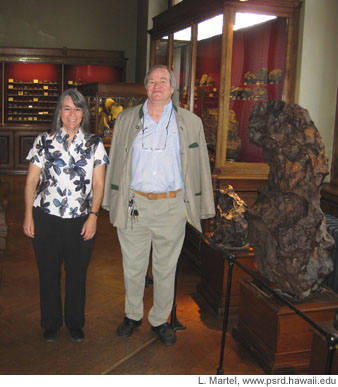 |
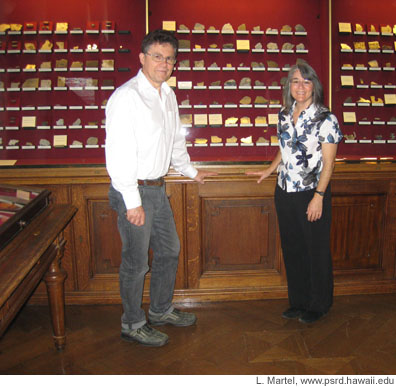 |
PSRD's Linda Martel with Dr. Gero Kurat, Emeritus Head of the Department of Mineralogy and Petrography (left photo) and Dr. Franz Brandstätter, Curator of the meteorite collection (right photo) in the meteorite hall next to some of the large iron meteorites and smaller labeled pieces in the wall cabinets. | |
What began in 1748 as a private collection of mainly minerals, fossils, and shells acquired by Emperor Franz I Stephan became a government entity in 1765 when Empress Maria Theresia presented it to the Austrian state after the Emperor's death.
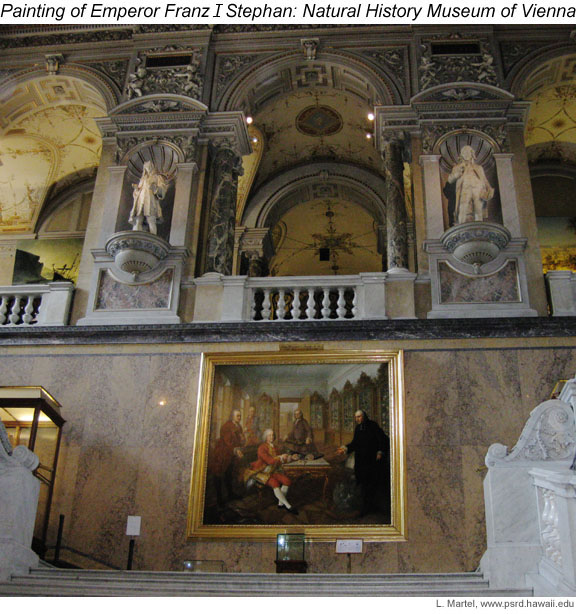 |
1748 marked the official start of the Viennese Imperial Natural History Cabinet. At that time it was the largest collection of its kind with 30,000 samples of minerals, fossils, shells, and snails. Directors added meteorites to the collection not long afterwards. This painting, gracing the wall of one of the grand staircases in the museum, shows Emperor Franz I Stephan (seated) with directors of his collections. |
The collection, then known as the Natural History Cabinet, expanded in 1778 to include two unique samples (meteorites) stored previously in the Imperial and Royal Treasury. Thus the Vienna meteorite collection was born in a time in history when the science of meteoritics had not yet emerged from the realm of debate and disbelief that stones fall from space, even though plenty of eyewitnesses had told stories of "thunderstones" falling to the ground.
The shift in thinking about meteorites happened around the year 1800. The story weaves a fascinating string of natural and human events from the late 1790s and turn of the century that eventually convinced the scientific community of the veracity of stones falling to Earth from space.
Most agree the first event was the publication of Ernst Chladni's book in 1794 in which he made the case that meteorites are extraterrestrial material. He was a lawyer by training (only because his father insisted upon it) who loved physics, especially problems in acoustics, and nurtured a keen interest in meteorites! Though Chladni had compiled an impressive amount of data on several iron meteorites, his book was not well received (to put it mildly) by the scientists of the day. But several successive events helped to change everything. In 1795, on a December afternoon in Wold Cottage, England, eyewitnesses saw yet another stone fall from the sky. This time British chemist, Edward Howard, analyzed the meteorite, found nickel-iron similar in composition to the iron described in Chladni's book, and published his own results in 1802. Wold Cottage was one of four meteorite falls recorded between the years 1794 and 1798 that helped to build the case for the extraterrerstrial origin of meteorites. These falls were followed by the monumental 1803 meteorite shower in L'Aigle, France where the citizens witnessed a fireball streak across the sky in broad daylight followed by more than 3,000 fragments falling in "a rain of stones." The Vienna collection contains many pieces of the L'Aigle meteorite [Data link from the Meteoritical Bulletin].
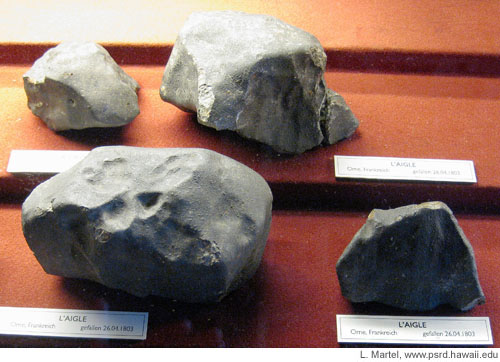 | |
| Samples on display of L'Aigle meteorite, type L6 ordinary chondrite. | |
The on-site scientific investigation and report of L'Aigle by Jean-Baptiste Biot, a young scientist of the Academie Francaise, helped persuade the remaining scientific skeptics in Europe that meteorites are rocks from space. The case was strengthened by the new understanding that space was not completely empty; the first asteroid (now designated a dwarf planet), 1 Ceres, was discovered in 1801 by Italian astronomer Piazzi. Then, across the Atlantic Ocean, an observed fireball in 1807 in Weston, Connecticut became the first documented meteorite fall in the United States.
Interestingly, the term we still use, meteorite, comes from the original thinking that the rocks were some sort of bizarre atmospheric phenomena (thunderstone, air stone) perhaps associated with lightening, condensation in clouds or volcanic eruptions, anything but rocks from outer space.
Throughout its 200+ years of existence, the Vienna collection has grown, and continues to grow, through purchases or trades for specimens or by acquiring entire private meteorite collections. The true beauty of the Vienna collection is its size and scope and number of historically significant samples that give it an intimate connection with the founding of meteoritics.
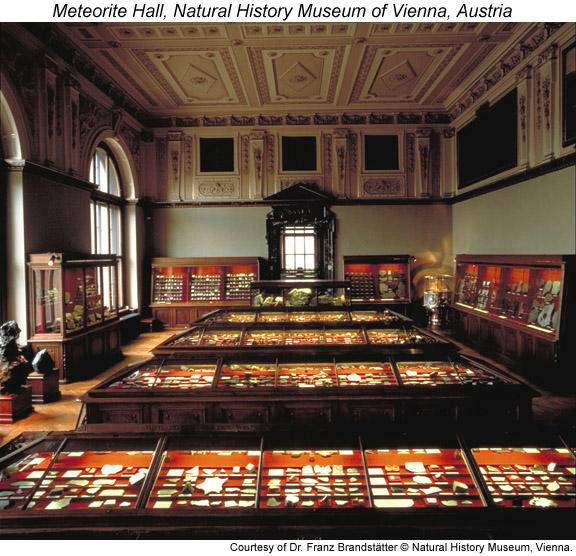 | |
About 5,000 samples are on display in the meteorite hall. Systematic collections of the major types of meteorites are labeled and displayed in the glass-topped table cases. The showcases on the walls are devoted to special topics or larger collections. | |
All the major types of meteorites are represented in the Vienna collection, which contains about 8,500 specimens from about 2,400 localities. The meteorite hall displays about 5,000 samples representing 1,000 different meteorites! Dr. Kurat and Dr. Brandstätter shared many stories of the famous pieces in their care. Here are but a few of the highlights--enough to kindle your curiosity and, perhaps, encourage a trip to the museum.
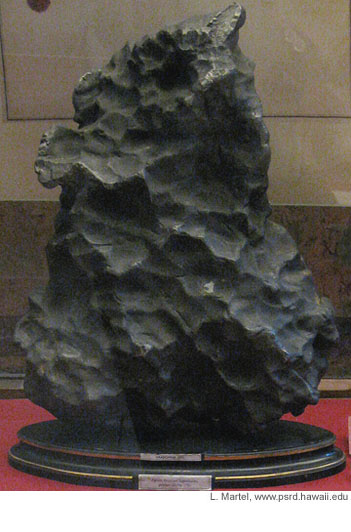 |
 |
(Left) This 39 kilogram piece is the main mass of the Hraschina iron meteorite. It was delivered to Emperor Franz I Stephan and became the founding piece of the Vienna meteorite collection. (Right) An ancient drawing by M. W. Haidinger depicts the fall of the Hraschina meteorite in 1751 based on eyewitness accounts. | |
Iron meteorites consist mainly of iron-nickel metal. The remarkable texture of the crystal structure is revealed in cut surfaces that are polished and etched with acid (see photo below). This banded texture is due to exsolution (unmixing) of one iron-nickel alloy (kamacite, low nickel) in an original alloy (higher nickel, taenite) during slow cooling. Viennese metallurgist Alois Beck von Widmanstätten discovered the texture in 1808 by flame heating samples of the Hraschina iron meteorite. Though another scientist, G. Thompson, had also discovered the texture, Widmanstätten's work was recognized by Carl van Schreibers (then Director of the Vienna Natural History Cabinet) and the term Widmanstätten has been used to describe the texture ever since.
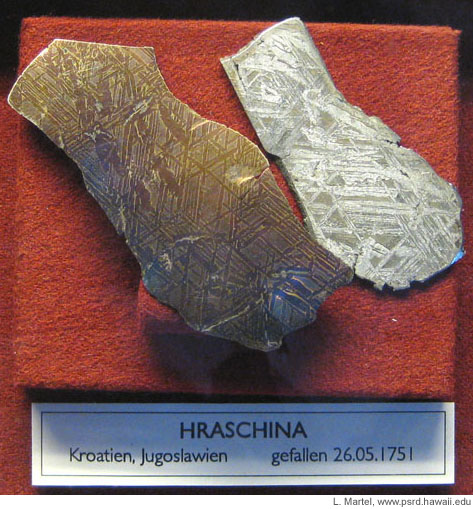 |
| These cut surfaces of the Hraschina iron meteorite show Widmanstätten texture. |
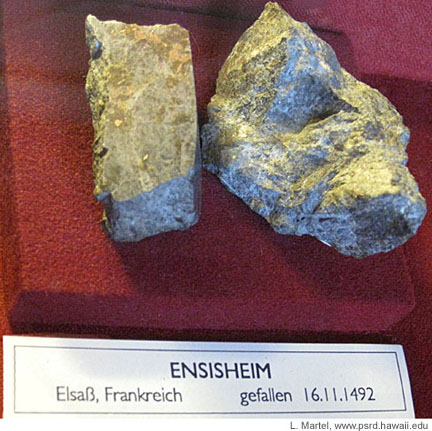 |
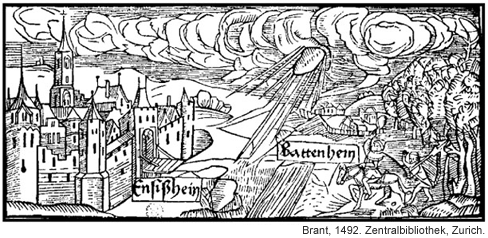 |
(Top) Photo of pieces of Ensisheim meteorite in the Vienna collection. (Bottom) Woodcuts, such as the one shown here, and text by poet Sebastian Brant helped to publicize the fall of the Ensisheim meteorite and its link to Maximilian I, King of the Romans. |
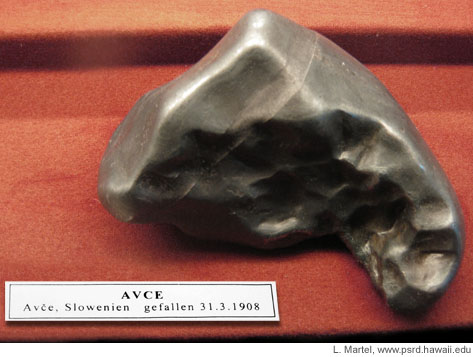 |
 |
| (Left) Avce, the iron meteorite that fell 101 years ago and was feared initially as a cannonball. (Right) Postcard and stamp issued in 2008 commemorating the 100-year anniversary of the meteorite's fall. | |
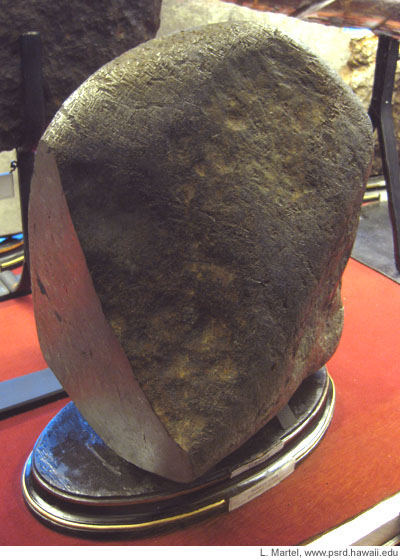 |
Elbogen iron meteorite was fixed with chains in a castle dungeon, presumably to restrain it from flying off as violently as it had fallen! |
 |
"On the morning after our arrival a remarkable phenomenon occurred of which we were witnesses. While the heavens were quite clear, a thick black cloud formed itself over the island... the densest portion of the cloud hung over the town of Hanaruro. The wind was perfectly calm, until all of a sudden, a violent gust blew from the northeast, and at the same time, a crashing noise proceeded from the cloud as if many ships were firing their guns. The concussion lasted some minutes, and when it ceased, two stones shot from the cloud into the street of Hanaruro and from the violence of the fall broke into several pieces. The inhabitants collected the still-warm fragments and judging by them, the stones must have weighed a full 15 pounds each. They were grey inside and were extensively surrounded by a black, burnt crust."Pictured on the left is the Honolulu meteorite, L5 chondrite, that fell in 1825. Right edge still has the black fusion crust. |
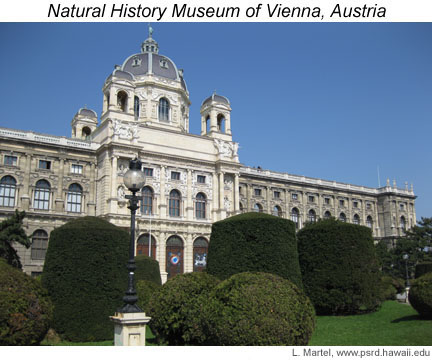 |
A set of twin beautiful buildings were constructed specifically for the museums of natural history (shown here) and art history on Vienna's famed Ringstrasse, the road circling the central district of the city. They opened to the public in 1889. In addition to the impressive hall of meteorites, the Natural History Museum holds millions of specimens carefully displayed in breathtaking surroundings with something to fascinate every visitor. |
Address: Natural History Museum, Burgring 7, A-1010, Vienna, Austria.
Hours: The museum is open Wednesday from 9 a.m. to 9 p.m., Thursday through Monday 9 a.m. to 6:30 p.m. Closed on Tuesday.
Admission: General admission is 8 Euro for adults.
Website: http://www.nhm-wien.ac.at/.
|
|
[ About PSRD |
Archive |
Search |
Subscribe ] [ Glossary | General Resources | Comments | Top of page ] |